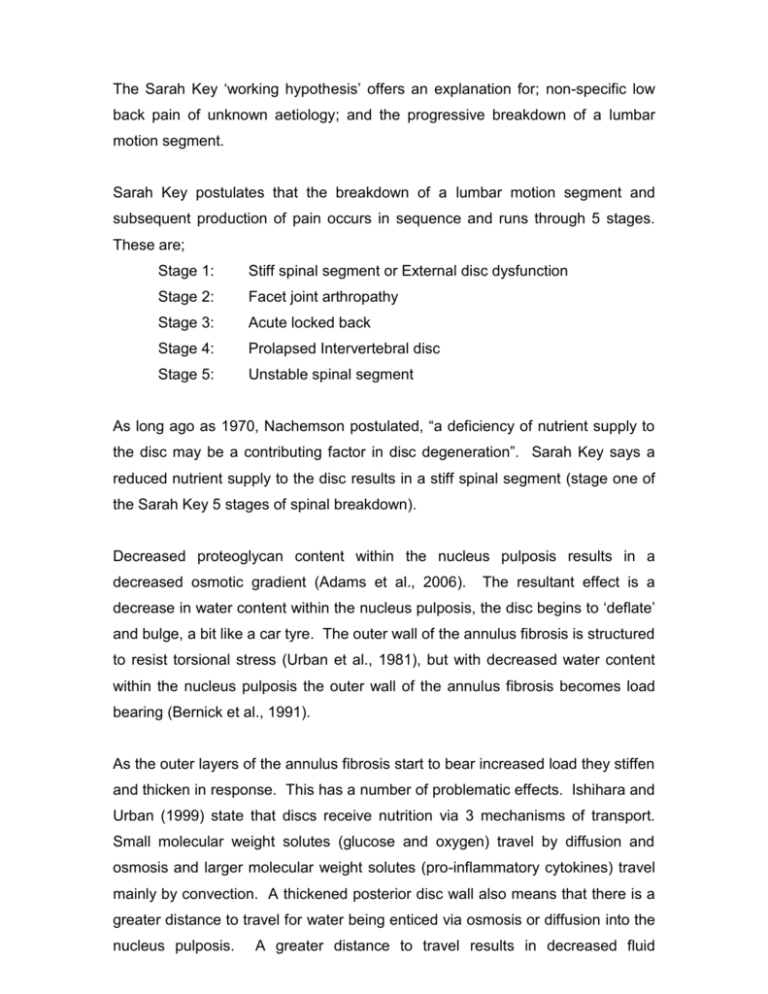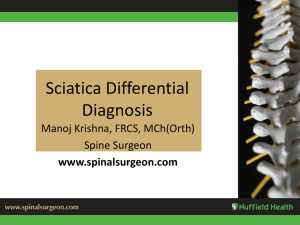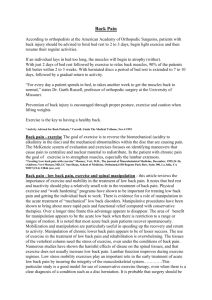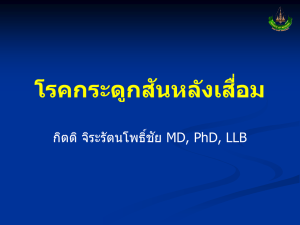Sarah Key summary essay ( 60kb)
advertisement

The Sarah Key ‘working hypothesis’ offers an explanation for; non-specific low back pain of unknown aetiology; and the progressive breakdown of a lumbar motion segment. Sarah Key postulates that the breakdown of a lumbar motion segment and subsequent production of pain occurs in sequence and runs through 5 stages. These are; Stage 1: Stiff spinal segment or External disc dysfunction Stage 2: Facet joint arthropathy Stage 3: Acute locked back Stage 4: Prolapsed Intervertebral disc Stage 5: Unstable spinal segment As long ago as 1970, Nachemson postulated, “a deficiency of nutrient supply to the disc may be a contributing factor in disc degeneration”. Sarah Key says a reduced nutrient supply to the disc results in a stiff spinal segment (stage one of the Sarah Key 5 stages of spinal breakdown). Decreased proteoglycan content within the nucleus pulposis results in a decreased osmotic gradient (Adams et al., 2006). The resultant effect is a decrease in water content within the nucleus pulposis, the disc begins to ‘deflate’ and bulge, a bit like a car tyre. The outer wall of the annulus fibrosis is structured to resist torsional stress (Urban et al., 1981), but with decreased water content within the nucleus pulposis the outer wall of the annulus fibrosis becomes load bearing (Bernick et al., 1991). As the outer layers of the annulus fibrosis start to bear increased load they stiffen and thicken in response. This has a number of problematic effects. Ishihara and Urban (1999) state that discs receive nutrition via 3 mechanisms of transport. Small molecular weight solutes (glucose and oxygen) travel by diffusion and osmosis and larger molecular weight solutes (pro-inflammatory cytokines) travel mainly by convection. A thickened posterior disc wall also means that there is a greater distance to travel for water being enticed via osmosis or diffusion into the nucleus pulposis. A greater distance to travel results in decreased fluid exchange which obviously leads to further decrease in water content within the nucleus pulposis and results in further thickening of the posterior disc wall, annulus fibrosis (Adams et al., 1996). A second problematic effect of a tight and thick posterior disc wall is that it inhibits or restricts stretch of the posterior disc wall. If the posterior disc wall is thickened, stiff and resistant to stretch it means it cannot drive its convection ‘pump’ effectively (Ishihara et al., 1995). This again results in a reduction in fluid exchange between the external and internal disc environment, leading to decreased water content within the nucleus pulposis, further stiffening of the posterior disc wall and decreasing proteoglycan synthesis and decreased proteoglycan content within the nucleus pulposis (Ishihara et al. 1995). Coppes et al., (1997) state that degenerate discs have more extensive nerve innervation. Kuslich et al., (1991) state, “by far the most common painful tissue (of the back) is the outer layer of the annulus and the posterior longitudinal ligament”. Bogduk (1991) also agrees stating, “Compression injuries of the disc are initially asymptomatic but may set in train a degradative process that, in time, leads to internal disc disruption, which becomes symptomatic as a result of chemical or mechanical irritation of nociceptors in the outer annulus fibrosis”. Sarah Key believes to overcome this problem you must stretch the posterior disc wall and encourage fluid back into the nucleus though mild traction and increasing the convection pump. By stretching the posterior disc wall she believes you can reduce scarring and reduce the thickness of the disc wall making fluid exchange easier. This will help restore disc health and disc nutrition. With mild traction a negative pressure is produced within the disc which helps attract water to the nucleus pulposis via the lateral and anterior aspects of the disc wall, as well as through the end plates and of course through the posterior disc wall. The resultant effect is a plumper, healthier disc. With a plumper, healthier disc there is less irritation or sensitisation of the mechanoreceptors and chemo-receptors. A lumbar intervertebral disc has a number of roles. As well providing shock absorption for a lumbar motion segment a disc also acts as a spacer for the posterior section of the motion segment, the facet joints. Sarah Key’s second stage of spinal breakdown is facet joint arthropathy. She postulates that facet arthropathy is secondary to a stiff spinal segment. Dunlop et al., (1984) support Sarah Key’s postulation stating, when a disc loses height the facets over-ride, increasing load baring through the facet surface by up to 70%, they should only bear approximately 16% of load. To fix this problem Sarah Key believes one must work in reverse. Unload the facet joints and stiff spinal segment. By ‘plumping up’ the stiff spinal segment the overall effect will be decreased load bearing through the facets. Sarah Key’s third stage of spinal breakdown is an acute locked back. Sarah postulates the acute facet locking is a hiccup in the spines coordinated control which results in minute subluxation of a facet (Sarah Key Masterclass, level one notes). Adams et al., (1996) demonstrated that multifidus fibres blend with the facet joint capsule and help to uplift one facet on another in flexion. Ng et al. (2003) demonstrated that fatigue could delay the reaction time of multifidus in response to load so that injury to the spine may occur. They also said that overreaction of muscles can follow delayed reaction of multifidus resulting in excessive compressive forces. Adams et al. (1996) state that a stiff spinal segment predisposes to acute facet locking because the disc is flatter and the upper vertebrae in the spinal motion segment is poorly spring loaded to flexion. After you have reduced the presenting symptoms of muscular spasm and movement dysfunction Sarah Key says, fix the reduction in disc height and you will reduce the incidence of acute lock-ups. If you increase the disc height (by encouraging fluid into the disc) the motion segment is primed / spring loaded, ready to bend with its surrounding muscles at optimal length tension relationship. Stage four of the five stages of spinal breakdown is a prolapsed intervertebral disc. Sarah Key believes disc prolapse is rare and predated by degeneration (stiff spinal segment) which lowers intra discal pressure and renders the nucleus ‘expressible’. Bogduk agrees that a prolapsed intervertebral disc starts off as a stiff spinal segment. Bogduk (1991) states, “Disc prolapse is but one possible end stage of internal disc disruption and represents the culmination of a series of destructive processes affecting the disc”. Mooney (1987) also supports Sarah Key’s postulation and found epidemiologically, disc prolapse accounts for fewer than 5% of presentations of low back pain. Once again, after the ‘acute phase’ of disc prolapse is over (medication and bed rest) one should move towards dealing with the core of the problem. If you can increase the proteoglycan content of the disc you can assist in restoring its health. This is done by reducing compressive muscle spasm in the lumbar erectors, normalising pressure in a stiff motion segment and decreasing a thick scarred posterior disc wall so fluid exchange is optimised with a follow on effect of increased disc health. Stage five is an unstable spinal segment. Sarah Key’s proposition is that a segment becomes unstable when the two main stabilising structures degenerate (the discs and facets). Twomey et al., (1985) support this notion. For the same reason this stage behaves very much like an acute lock up. The major difference is there is radiographic evidence with this stage which is not often present with an acute lock up. The disc has ‘deflated’ so much that it allows anterior shear of the motion segment. The body tries to stabilise and the resultant effect is ‘traction spurs’ of the vertebral bodies as they try to meet and facet trophism, again as they look to provide bony support. With the loss of the passive subsystem (Panjabi, 1992) the therapists job is to assist in stabilising through the active and control systems to prevent increased segmental shear. Lotz et al., (2006) sum it up well stating, ‘loss of nuclear volume (and, consequently, pressure) is a common trigger for tissue remodelling and anatomical change consistent with disc degeneration in humans’. Reference List 1. Adams MA, Bogduk N, Burton K, Dolan P. The Biomechanics of Back Pain. Churchill Livingstone (2nd Ed.) , 2006 2. Adams MA, Dolan P. Spine Biomechanics. Journal of Biomechanics 2005. Oct; 38(10): 1972-1983 3. Adams et al. Mechanical Initiation of IVD degeneration. Spine 2000. 25 (13) PP 1625-1636 4. Bernick S, Walter JM, Paule WJ. Age changes to the annulus fibrosis in the human IVD. Spine: 1991. 16: 520-524 5. Bogduk N. Management of Chronic Low Back Pain. Medical Journal of Australia, Jan, 2004. Vol 1880 pp70-83 6. Bogduk N. The lumbar discs and low back pain. Neurosurg Clin N Am. 1991. Oct; 2(4) 791-80 7. Bogduk N. Clinical Anatomy of the Lumbar Spine. Churchill Livingstone, 2006 8. Coppes MH, Marani E, Thomeer RT, Groen GJ. Innervation of ‘painful’ lumbar discs. Spine. 1997. Oct 15;22(20): 2342-9; discussion 2349-50 9. Dolan P, Adams MA. Recent advances in lumbar spinal mechanics and their significance for modelling. Clinical biomechanics 16 Supplement No 1 (2001) S8-S16 Ishihara H, Urban JP. Effects of low oxygen concentrations and metabolic inhibitors on proteoglycan and protein synthesis rates in the IVD. Jl of Ortho research. 1999. 17: 829-835 10. Dunlop RB, Adams MA, Hutton WC. Disc space narrowing and the lumbar facet joints. Jl Bone Joint Sur. Br. 1984. Nov; 66(5): 706 11. Kuslich SD, Ulstrom CL, Michael CJ. The tissue origin of low back pain and sciatica: a report fo pain response to tissue stimulation during operations of the lumbar spine using local anaesthesia. Ortho clin Nth Am. 1991. Apr; 22(2): 181-187 12. Kroeber M, Unglaub F, Guehring T, Nerlich A, Hadi T, Lotz J, Carstens C. Effects of controlled dynamic distraction on degenerated IVD’s: an in vivo study on the rabbit lumbar spine model. Z Orthop Ihre Grenzgeb 2006. Jan-Feb; 144(1): 68-73 13. Lotz JC, Kim AJ. Disc regeneration; why, when, and how. Neurosurg Clin N Am. 2005 Oct; 16(4): 657-663, vii 14. McMillan DW, Garbutt G, Adams MA. Effects of sustained loading on water content of IVD’s: Implications for disc metabolism. Ann Rheum Dis 1996. Dec; 55(12) 880-887 Nachemson A., et al. In vitro diffusion of dye through the end-plates and the annulus fibrosis in the human IVD. Acta Orthopaedica Scandinavica 41, 1970. 15. Mooney V. Where is the pain coming from? Spine 1987 12: 754-759 16. Ng, Parnianpour, Richardson, Kippers. Effect of fatigue on torque output and EMG measures of trunk muscles during isometric axial rotation. Arch Phys. Med Rehab. 2003. Vol 84, 17. Schnake KJ, Putzier M, Hass NP, Kandziora F. Mechanical concepts for disc regeneration. Eur Spine J. 2006. Jul 12 18. Twomey LT, Taylor JR. Age changes of the articular triad. The Aust. Jl. of Physio. 1985. Vol 31, no 3 19. Urban JP, Roberts S. Chemistry of the IVD in relation to functional requirements. Chpt 5 Grieves Modern Manual Therapy. The Vertebral Column. 3rd Edition Elsevier Churchill Livingstone Urban JP, Maroudas A. Swelling of the IVD in vitro. Connective Tissue Research 1981. Vol 9: 1-10








